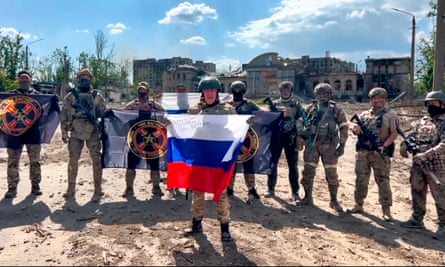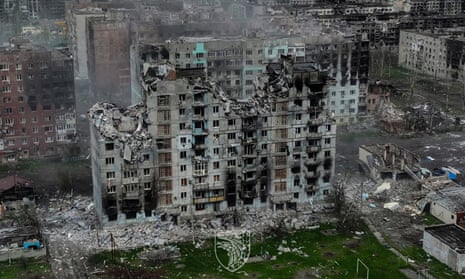Russia appeared close to taking control of Bakhmut on Monday, although Ukraine said it continued to fight on in the south-west fringes of the city largely devastated by an intense year of deadly fighting.
Hanna Mailar, Ukraine’s deputy defence minister, said Ukraine still controlled “certain facilities” in the Litak district, but reports said the defenders had lost control of the last of the remaining high-rises in the eastern Ukrainian city.
Ukraine has switched its primary focus to engaging in limited counterattacks on the higher ground to the immediate north-west and south of the ruined city, which could be used to threaten the Russian attackers below.
“The offensive potential of the enemy has been significantly reduced, huge losses have been inflicted on the enemy” Mailar said. She added: “We have gained time for certain actions, which will be discussed later.”
Bakhmut was first shelled in May 2022 and Russian forces consistently targeted the mining city that had a pre-war population of about 70,000. Although not considered of particular strategic value, the city has acquired a high symbolic value for both sides in the conflict.
The two sides fought building by building in the most intense fighting seen in Europe since the end of the second world war, with Russia taking a year to advance about 24km on the Bakhmut sector of the eastern Donbas, a front that has otherwise remained relatively static since last autumn.
The effort was led by the Russian mercenary Wagner group, using seasoned veterans to command a large number of former prisoners. But experts question whether, as the battle draws to an end, Wagner can continue to fight further.
The Institute of the Study of War said on Sunday night it believed Wagner’s offensive was likely to be at its culmination point and that “it is unlikely that Wagner will continue fighting beyond Bakhmut at its current depleted state”.
Joe Biden, the US president, said at the G7 summit in Japan that Russia had suffered 100,000 casualties, killed and wounded, in fighting for the city, higher than previous Ukrainian estimates of 70,000. Ukraine does not release casualty figures but it is believed to have lost tens of thousands in the protracted struggle.
Wagner’s chief, Yevgeny Prigozhin, declared on Saturday that Bakhmut had fallen, filming himself at the city’s battered railway station a few kilometres behind the frontline. Other video footage showed Russian troops waving flags at the western edge of the city, although not in the Litak district still being fought over.
At that point, Prigozhin announced Wagner forces would withdraw from the city by Thursday, leaving its defence to regular Russian troops, although it was unclear whether that was a firm declaration of intent, or a feint designed to lure Ukrainian forces back into attacking the city.
after newsletter promotion

Attacking forces are often considered at their most vulnerable when an advance culminates, usually due to combat exhaustion, and Ukraine has been hinting that it hopes to surround the invaders in the city by attacking to the north and south.
But the Ukrainian counterattacks remain relatively limited so far, and the expectation is that Kyiv will soon launch a more significant assault as the weather improves, using about 12 brigades-worth of troops, many of which have been equipped with western tanks, fighting vehicles and artillery.
Three civilians were killed and 14 injured across Ukraine in overnight shelling while the country’s air force said it had shot down four cruise missiles and 20 drones. But the air force spokesperson Yuri Inhat said Ukraine did not “have enough means” – air defences – to deal with high-speed ballistic missiles across the country.
Ukraine said it had reconnected the Russian-occupied Zaporizhzhia nuclear power plant to its external power supply after a brief outage that had left it reliant on emergency generators. Backup diesel generators were in use for a time at the site, to ensure nuclear fuel was kept cool and prevent a potential disaster.
It is the seventh time during the war that the nuclear power plant, Europe’s biggest, has had to switch to backup power. Russian forces seized the plant early in the war.
